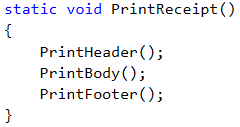Good Practices When Working with Methods
Let's remind you that a method should do only one defined task. If this cannot be done, you must think how to split the method into a few, smaller ones. As we already said the name of the method should be clear and should describe its purpose. Another good practice in programming is to avoid methods, which are longer than a typical screen size (approximately). If the code still becomes large it is recommended to split it into several, shorter methods, as in the example below.

Code Structure and Formatting
When writing methods, we should be careful to use correct indentation (moving blocks of the code to the right).
Example for correctly formatted C# code:

Example for incorrectly formatted C# code:

When the declaration line of the method is too long, it is recommended to split it into several lines, as each line after the first one is two tabulations to the right of the first one (for better readability):

Another good practice when writing code is to leave an empty line between the methods, after loops and conditional statements. Also try to abstain from writing long lines and complicated expressions. With time you will see that this makes the readability better and saves time.
It is also recommended to always use curly brackets for the bodies of conditional statements and loops. The brackets not only improve readability, but also reduce the possibility to make a mistake and the program to run incorrectly.